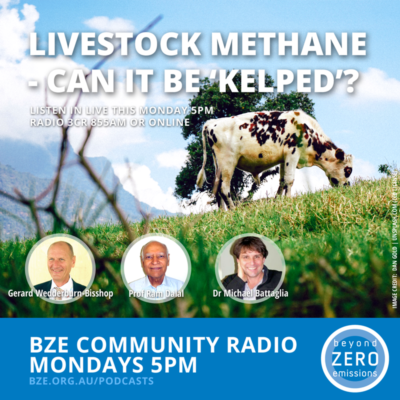
“It’s about time the role agriculture plays in the climate crisis – and the role it COULD play in the solution – got a concentrated dose of attention.” Bill Mc Kibben
Our 26 million head-strong beef cattle – and 75 million head of sheep – ruminant meat and livestock industry is now responsible for more than half of Australia’s GHG’s and methane, and the near term climate change they are creating. So, is this an industry that can ever really be climate-safe?
Gerard Wedderburn-Bisshop, University of Queensland’s Professor Ram Dalal and CSIRO’s Dr Michael Battaglia will join BZE Radio’s Vivien Langford to consider:
Thank you to our guests:
The big news is that, globally, methane concentrations are on the rise. And the accelerated ‘near-term’ warming this causes is now largely thought to come down to ‘livestock methane’, aka animal agriculture. So, in this show, BZE Radio begins to shine a light on livestock methane.
Of course, the question on everybody’s lips is ‘what are the opportunities available to us to change the way we do animal agriculture and that could make the best impact in the shortest possible timeframe. Can we do that in a way that is great for family farmers, good for our biggest high-emitting agricultural corporate players, and for regional Australia as a whole?’
In Australia the opportunities for mitigating animal agriculture GHGs are a little hidden from view. Why?
Well, the fact is that our go-to GHG inventory, the national inventory report (NIR), masks the fact that animal agricultural activities are our single largest source of GHG emissions each year. In fact most of us, incorrectly, assume the NIR is correct when it tells us that our electricity generation sector is Australia’s largest emitter.
Looking at the impact on this decade and the next one, according to BZE analysis of ‘excluded’ GHGs and near-term impacts, agricultural activities contribute to over 50% of our annual national total emissions. And so, if remedied, could halve our national emissions.
How can we most effectively address the low-profile but high-impact non-CO2 GHG’s – especially methane, but also carbon monoxide, carbon black, tropospheric ozone, and nitrous oxide? These gases all arise from animal agriculture, including savanna burning, land-clearing, re-clearing and growing feed via industrialised agriculture.
This area of research is grippingly important. It’s why we are thrilled to bring you a program highlighting what we can do in agriculture right now that will have the best climate impact.
Next week we will look at the impact of Land clearing on climate change. In Australia 90% of land clearing and re-clearing is for extending and maintaining rangelands for both domestic and export cattle production. Immediately ceasing land clearing and re-clearing is therefore a major opportunity for GHG mitigation.
Further reading:
Zero Carbon Australia Land use: Agriculture and Forestry Discussion Paper 2014
Seaweed Could Hold the Key to Cutting Methane Emissions from Cow Burps
What’s At Steak: The Real Cost of Meat Global Forest Coalition 2016
Tackling Climate Change through Livestock: A global assessment of emissions and mitigation opportunities, Food and Agriculture Organization Full PDF Article summary
This show is dedicated to Goldman Environmental Prize winner and farmer Wendy Bowman, as well as all those many farmers still mopping up after Cyclone Debbie.
If you’d like to contribute to the restoration of normality for farmers affected by the cyclone, please join us in supporting the Foundation for Rural and Regional Renewal’s Cyclone Debbie Restoration Fund – sometimes even the most resilient communities need a helping hand. 03 54302399 www.frrr.org.au http://www.frrr.org.au/cb_…/cyclone_debbie_recovery_fund.php
Climate Action Collective